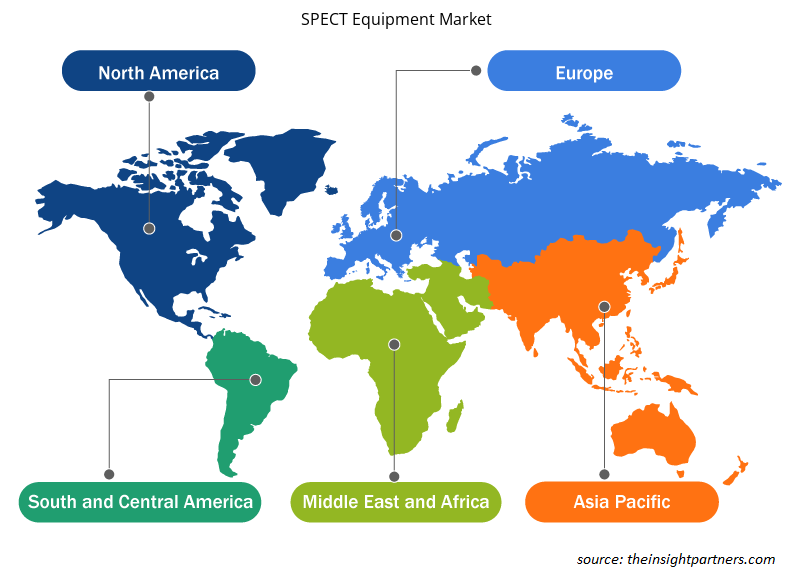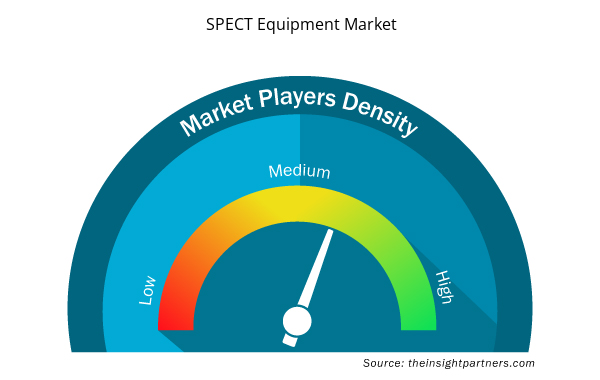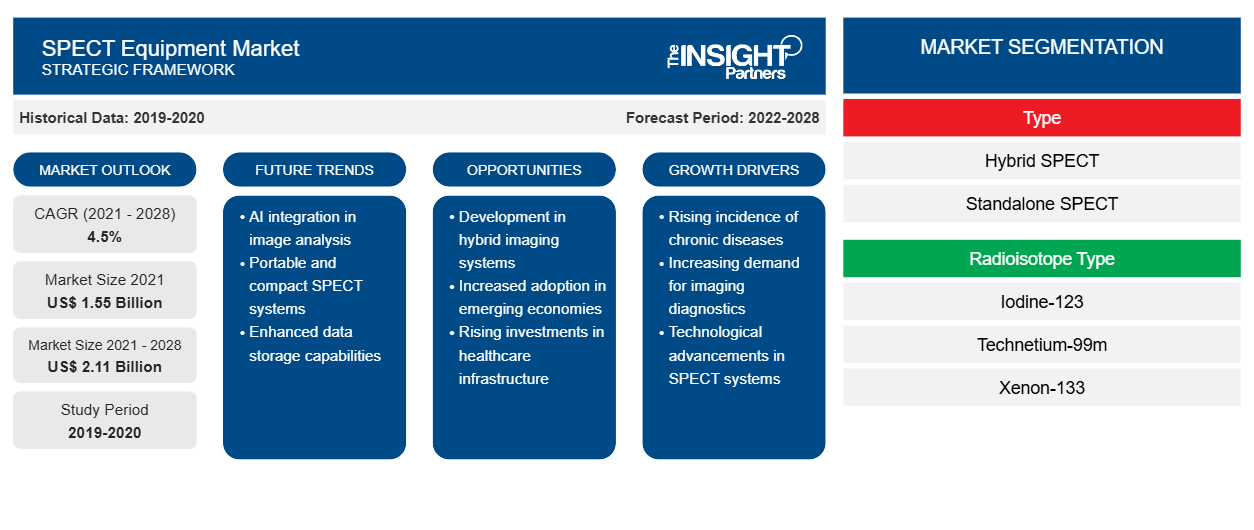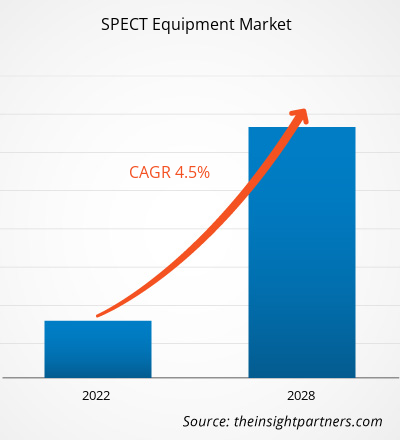Si prevede che il mercato delle apparecchiature SPECT raggiungerà i 2.109,05 milioni di dollari entro il 2028, rispetto ai 1.552,02 milioni di dollari del 2021; si prevede una crescita a un CAGR del 4,5% dal 2021 al 2028.SPECT Equipment Market is projected to reach US$ 2,109.05 million by 2028 from US$ 1,552.02 million in 2021; it is expected to grow at a CAGR of 4.5% from 2021 to 2028.
SPECT è una tecnica di imaging che aiuta a notare i cambiamenti fisiologici negli organi e nei tessuti del corpo. SPECT è un coadiuvante nella diagnosi precoce di condizioni, nel monitoraggio della terapia o addirittura nell'esecuzione di esplorazioni sulla fisiologia umana. La SPECT autonoma è una classe di sistemi di imaging di medicina nucleare che utilizza raggi gamma. La macchina rileva le scariche di raggi gamma da un radioisotopo iniettato per generare immagini per scopi di diagnosi e gestione delle malattie, in quanto può produrre immagini tomografiche di alta qualità a corpo intero in tempo reale. La SPECT ibrida è un ibrido delle due tecnologie di imaging in cui sia la gamma camera che i dispositivi PET vengono utilizzati insieme durante la segnalazione delle immagini. Migliora la qualità delle immagini riducendo al contempo la dose di radiazioni ai pazienti che subiscono queste scansioni costantemente, specialmente nelle applicazioni oncologiche.
Il rapporto offre approfondimenti e analisi approfondite del mercato delle apparecchiature SPECT, sottolineando vari parametri come tendenze di mercato, progressi tecnologici, dinamiche di mercato e analisi del panorama competitivo dei principali attori del mercato in tutto il mondo. Include anche l'impatto della pandemia di COVID-19 sul mercato in tutte le regioni. La pandemia ha sconvolto le condizioni socioeconomiche di vari paesi in tutto il mondo. Attualmente, gli Stati Uniti sono il paese più colpito al mondo a causa dell'epidemia di COVID-19 con il numero più alto di casi confermati e decessi, secondo le recenti statistiche dell'OMS. L'elevato numero di casi positivi al COVID-19 ha avuto un impatto negativo sulle economie globali. C'è stato un calo delle attività commerciali complessive e la crescita di vari settori che operano in tutto il mondo.
Secondo la Society of Nuclear Medicine and Molecular Imaging (SNMMI), quasi l'80% degli intervistati ha registrato cali del 50%-75% nelle procedure di imaging di medicina nucleare. Negli Stati Uniti, a causa di un numero crescente di pazienti infetti da COVID-19 e di varianti letali del coronavirus, le attività di diagnostica e imaging sono terminate durante la pandemia. Pertanto, la diagnosi complessiva delle malattie croniche con apparecchiature SPECT è stata ritardata e ha ostacolato il mercato delle apparecchiature SPECT nordamericano. Pertanto, la pandemia di COVID-19 ha un potenziale impatto economico sulla maggior parte dei settori, come le procedure oncologiche. La pandemia ha ostacolato la diagnosi e gli interventi chirurgici del cancro ed è probabile che avrà un impatto negativo sul mercato nei prossimi anni.
In base alla regione, il mercato delle apparecchiature SPECT è segmentato in Nord America, Europa, Asia Pacifico, Medio Oriente e Africa, Sud e Centro America.
Personalizza questo report in base alle tue esigenze
Riceverai la personalizzazione gratuita di qualsiasi report, comprese parti di questo report, o analisi a livello nazionale, pacchetto dati Excel, oltre a usufruire di grandi offerte e sconti per start-up e università
- Scopri le principali tendenze di mercato in questo rapporto.Questo campione GRATUITO includerà analisi di dati che spaziano dalle tendenze di mercato alle stime e alle previsioni.
Approfondimenti di mercato
Progressi nell'analisi dell'imaging tumorale
Il gallio-67 è un gold standard per la diagnosi e la stadiazione dei tumori. L'imaging ibrido con Ga-67 SPECT/CT consente la localizzazione delle lesioni del linfoma. Il Ga-67 è un agente utilizzato principalmente per l'imaging dell'infiammazione, perché può accumularsi in modo non specifico nelle aree infiammate come un complesso metallo-transferrina, seguito da un ulteriore legame ai recettori della transferrina. Alcuni degli attori del mercato che forniscono il citrato di gallio GA-67 sono Lantheus Medical Imaging e Mallinckrodt Nuclear. L'imaging diagnostico ha acquisito un ruolo significativo nella gestione dei pazienti affetti da cancro e ha fatto un ulteriore passo avanti con l'introduzione delle tecniche di fusione nel campo. La tecnologia SPECT fornisce immagini ibride di due modalità indipendenti, una tecnica scintigrafica funzionale e una procedura anatomica, producendo uno studio di imaging superiore. La scintigrafia si basa sull'uso di traccianti a singolo fotone o a emissione di positroni che forniscono una descrizione della funzione o dei processi, mentre la tomografia computerizzata (TC), l'ecografia o la risonanza magnetica per immagini (RMI) descrivono la localizzazione precisa e il tipo di cambiamenti morfologici che si sono verificati nelle lesioni. Secondo l'Agenzia internazionale per la ricerca sul cancro (IARC), entro il 2040 il numero di nuovi casi di cancro crescerà fino a 27,5 milioni. Inoltre, si prevede che il carico globale di cancro aumenterà del 70% nei prossimi 20 anni.
L'introduzione di un dispositivo di imaging ibrido (contenente un sistema TC a bassa dose e una gamma camera su un singolo gantry) ha consentito l'acquisizione sequenziale delle due modalità di imaging, con i dati successivi che si fondono in una visualizzazione di immagini composite. Ad esempio, la gamma camera SPECT-CT aiuta nella gestione della diagnosi del cancro ed è utilizzata in economie emergenti come l'India. L'ospedale INHS Asvini della Marina indiana ha una gamma camera SPECT-CT all'avanguardia nel sud di Mumbai. Si prevede che tali progressi nei metodi di rilevamento ridurranno l'incidenza dei tassi di cancro.
Informazioni basate sul tipo
In base al prodotto, il mercato delle apparecchiature SPECT è diviso in SPECT ibrido e SPECT autonomo. Il segmento SPECT ibrido ha rappresentato una quota maggiore del mercato. Il mercato per il segmento SPECT ibrido è ulteriormente diviso in SPECT-CT e SPECT-MR.
Approfondimenti basati sul tipo di radioisotopo
In base al tipo di radioisotopo, il mercato delle apparecchiature SPECT è segmentato in Iodio-123, Tecnezio-99m, Xenon-133, Tallio-201, Radio-223, Gallio-66 e Altri. Il segmento Tecnezio-99m ha detenuto la quota maggiore del mercato nel 2021, mentre si stima che il segmento Gallio-66 registrerà il CAGR più elevato nel mercato durante il periodo di previsione.
Approfondimenti basati sulle applicazioni
In base all'applicazione, il mercato delle apparecchiature SPECT è segmentato in crisi epilettiche, ictus, fratture da stress, infezioni, tumori e altri. Nel 2021, il segmento degli ictus ha detenuto la quota maggiore del mercato. Inoltre, si prevede che il segmento dei tumori registrerà il CAGR più elevato dal 2021 al 2028.
Informazioni basate sull'utente finale
In base all'utente finale, il mercato delle apparecchiature SPECT è segmentato in ospedali, centri di imaging e altri. Il segmento degli ospedali ha detenuto la quota maggiore del mercato nel 2021 e si prevede che il segmento dei centri di imaging registrerà il CAGR più elevato del mercato durante il periodo di previsione.
Gli operatori del mercato delle apparecchiature SPECT adottano strategie organiche, come il lancio e l'espansione dei prodotti, per espandere la propria presenza e il portafoglio prodotti in tutto il mondo e soddisfare la crescente domanda.
Approfondimenti regionali sul mercato delle apparecchiature SPECT
Le tendenze regionali e i fattori che influenzano il mercato delle apparecchiature SPECT durante il periodo di previsione sono stati ampiamente spiegati dagli analisti di Insight Partners. Questa sezione discute anche i segmenti e la geografia del mercato delle apparecchiature SPECT in Nord America, Europa, Asia Pacifico, Medio Oriente e Africa e America meridionale e centrale.

- Ottieni i dati specifici regionali per il mercato delle apparecchiature SPECT
Ambito del rapporto sul mercato delle apparecchiature SPECT
| Attributo del report | Dettagli |
|---|---|
| Dimensioni del mercato nel 2021 | 1,55 miliardi di dollari USA |
| Dimensioni del mercato entro il 2028 | 2,11 miliardi di dollari USA |
| CAGR globale (2021 - 2028) | 4,5% |
| Dati storici | 2019-2020 |
| Periodo di previsione | 2022-2028 |
| Segmenti coperti | Per tipo
|
| Regioni e Paesi coperti | America del Nord
|
| Leader di mercato e profili aziendali chiave |
|
Densità degli operatori del mercato delle apparecchiature SPECT: comprendere il suo impatto sulle dinamiche aziendali
Il mercato delle apparecchiature SPECT sta crescendo rapidamente, spinto dalla crescente domanda degli utenti finali dovuta a fattori quali l'evoluzione delle preferenze dei consumatori, i progressi tecnologici e una maggiore consapevolezza dei vantaggi del prodotto. Con l'aumento della domanda, le aziende stanno ampliando le loro offerte, innovando per soddisfare le esigenze dei consumatori e capitalizzando sulle tendenze emergenti, il che alimenta ulteriormente la crescita del mercato.
La densità degli operatori di mercato si riferisce alla distribuzione di aziende o società che operano in un particolare mercato o settore. Indica quanti concorrenti (operatori di mercato) sono presenti in un dato spazio di mercato in relazione alle sue dimensioni o al valore di mercato totale.
Le principali aziende che operano nel mercato delle apparecchiature SPECT sono:
- Cardinal Health, Inc.
- Curio
- Lantheus Medical Imaging, Inc.
- Mediso Ltd
- Radioisotopi NTP
Disclaimer : le aziende elencate sopra non sono classificate secondo un ordine particolare.

- Ottieni una panoramica dei principali attori del mercato delle apparecchiature SPECT
Il mercato delle apparecchiature SPECT è stato segmentato come segue:
Il mercato delle apparecchiature SPECT è segmentato in base a tipo, tipo di radioisotopo, applicazione, utente finale e area geografica. In base al tipo, il mercato è suddiviso in SPECT ibrida e SPECT autonoma. Il mercato per il segmento SPECT ibrido è ulteriormente suddiviso in SPECT-CT e SPECT-MR. In base al tipo di radioisotopo, il mercato delle apparecchiature SPECT è segmentato in Iodio-123, Tecnezio-99m, Xenon-133, Tallio-201, Radio-223, Gallio-66 e altri. In base all'applicazione, il mercato è segmentato in convulsioni, ictus, fratture da stress, infezioni, tumori e altri. In termini di utente finale, il mercato delle apparecchiature SPECT è segmentato in ospedali, centri di imaging e altri. In base all'area geografica, il mercato è segmentato in Nord America, Europa, Asia Pacifico (APAC), Medio Oriente e Africa (MEA) e Sud e Centro America (SCAM). Il mercato delle apparecchiature SPECT in Nord America è suddiviso in Stati Uniti, Canada e Messico. Il mercato in Europa è ulteriormente suddiviso in Francia, Germania, Regno Unito, Spagna, Italia e resto d'Europa. Il mercato delle apparecchiature SPECT in Asia Pacifico (APAC) è ulteriormente suddiviso in Cina, India, Giappone, Australia, Corea del Sud e resto dell'Asia Pacifico. Il mercato in Medio Oriente e Africa (MEA) è ulteriormente suddiviso in Arabia Saudita, Emirati Arabi Uniti, Sudafrica e resto del Medio Oriente e Africa. Il mercato delle apparecchiature SPECT in America meridionale e centrale (SCAM) è ulteriormente suddiviso in Brasile, Argentina e resto dell'America meridionale e centrale. I partecipanti aziendali inclusi nel nostro ambito di ricerca sonoCardinal Health Inc, Curium, Lantheus Medical Imaging, Inc.
,
Mediso Ltd
,
Radioisotopi NTP
,
Bracco Imaging SpA, Star Equity Holdings, Inc.
,
Tra gli altri, Bruker Corporation, MiE GmbH e Spectrum Dynamics Medical.
- Analisi storica (2 anni), anno base, previsione (7 anni) con CAGR
- Analisi PEST e SWOT
- Valore/volume delle dimensioni del mercato - Globale, regionale, nazionale
- Industria e panorama competitivo
- Set di dati Excel


- Fishing Equipment Market
- Small Satellite Market
- Batter and Breader Premixes Market
- Equipment Rental Software Market
- Wheat Protein Market
- Non-Emergency Medical Transportation Market
- Identity Verification Market
- Vision Guided Robotics Software Market
- Oxy-fuel Combustion Technology Market
- Sodium Bicarbonate Market

Report Coverage
Revenue forecast, Company Analysis, Industry landscape, Growth factors, and Trends

Segment Covered
This text is related
to segments covered.

Regional Scope
North America, Europe, Asia Pacific, Middle East & Africa, South & Central America

Country Scope
This text is related
to country scope.
Domande frequenti
The hospitals segment dominated the global SPECT equipment market and accounted for the largest revenue share of 50.36% in 2021.
The SPECT equipment market majorly consists of the players such as Cardinal Health, Inc., Curium, Lantheus Medical Imaging, Inc., Mediso Ltd., NTP Radioisotopes, Bracco Imaging S.p.A, Star Equity Holdings, Inc., Bruker Corporation, MiE GmbH and Spectrum Dynamics Medical., among others
The hybrid SPECT segment dominated the global SPECT equipment market and held the largest revenue share of 67.66% in 2021.
SPECT is an imaging technique with the eventuality to note physiological changes in organs and tissues within the body. SPECT adjuncts in the early diagnosis of conditions, monitoring therapy, or indeed carrying out exploration on human physiology. Standalone SPECT is a class of nuclear medicine imaging system that uses gamma beams. The machine detects the gamma-beam discharges from an injected radioisotope to generate images for diagnosis and ailment management purposes, as it can produce high-quality full-body tomographic images in real-time.
Trends and growth analysis reports related to Life Sciences : READ MORE..
The List of Companies - SPECT Equipment Market
- Cardinal Health, Inc.
- Curium
- Lantheus Medical Imaging, Inc.
- Mediso Ltd
- NTP Radioisotopes
- Bracco Imaging S.p.A.
- Star Equity Holdings, Inc.
- Bruker Corporation
- MiE GmbH
- Spectrum Dynamics Medical
The Insight Partners performs research in 4 major stages: Data Collection & Secondary Research, Primary Research, Data Analysis and Data Triangulation & Final Review.
- Data Collection and Secondary Research:
As a market research and consulting firm operating from a decade, we have published and advised several client across the globe. First step for any study will start with an assessment of currently available data and insights from existing reports. Further, historical and current market information is collected from Investor Presentations, Annual Reports, SEC Filings, etc., and other information related to company’s performance and market positioning are gathered from Paid Databases (Factiva, Hoovers, and Reuters) and various other publications available in public domain.
Several associations trade associates, technical forums, institutes, societies and organization are accessed to gain technical as well as market related insights through their publications such as research papers, blogs and press releases related to the studies are referred to get cues about the market. Further, white papers, journals, magazines, and other news articles published in last 3 years are scrutinized and analyzed to understand the current market trends.
- Primary Research:
The primarily interview analysis comprise of data obtained from industry participants interview and answers to survey questions gathered by in-house primary team.
For primary research, interviews are conducted with industry experts/CEOs/Marketing Managers/VPs/Subject Matter Experts from both demand and supply side to get a 360-degree view of the market. The primary team conducts several interviews based on the complexity of the markets to understand the various market trends and dynamics which makes research more credible and precise.
A typical research interview fulfils the following functions:
- Provides first-hand information on the market size, market trends, growth trends, competitive landscape, and outlook
- Validates and strengthens in-house secondary research findings
- Develops the analysis team’s expertise and market understanding
Primary research involves email interactions and telephone interviews for each market, category, segment, and sub-segment across geographies. The participants who typically take part in such a process include, but are not limited to:
- Industry participants: VPs, business development managers, market intelligence managers and national sales managers
- Outside experts: Valuation experts, research analysts and key opinion leaders specializing in the electronics and semiconductor industry.
Below is the breakup of our primary respondents by company, designation, and region:

Once we receive the confirmation from primary research sources or primary respondents, we finalize the base year market estimation and forecast the data as per the macroeconomic and microeconomic factors assessed during data collection.
- Data Analysis:
Once data is validated through both secondary as well as primary respondents, we finalize the market estimations by hypothesis formulation and factor analysis at regional and country level.
- Macro-Economic Factor Analysis:
We analyse macroeconomic indicators such the gross domestic product (GDP), increase in the demand for goods and services across industries, technological advancement, regional economic growth, governmental policies, the influence of COVID-19, PEST analysis, and other aspects. This analysis aids in setting benchmarks for various nations/regions and approximating market splits. Additionally, the general trend of the aforementioned components aid in determining the market's development possibilities.
- Country Level Data:
Various factors that are especially aligned to the country are taken into account to determine the market size for a certain area and country, including the presence of vendors, such as headquarters and offices, the country's GDP, demand patterns, and industry growth. To comprehend the market dynamics for the nation, a number of growth variables, inhibitors, application areas, and current market trends are researched. The aforementioned elements aid in determining the country's overall market's growth potential.
- Company Profile:
The “Table of Contents” is formulated by listing and analyzing more than 25 - 30 companies operating in the market ecosystem across geographies. However, we profile only 10 companies as a standard practice in our syndicate reports. These 10 companies comprise leading, emerging, and regional players. Nonetheless, our analysis is not restricted to the 10 listed companies, we also analyze other companies present in the market to develop a holistic view and understand the prevailing trends. The “Company Profiles” section in the report covers key facts, business description, products & services, financial information, SWOT analysis, and key developments. The financial information presented is extracted from the annual reports and official documents of the publicly listed companies. Upon collecting the information for the sections of respective companies, we verify them via various primary sources and then compile the data in respective company profiles. The company level information helps us in deriving the base number as well as in forecasting the market size.
- Developing Base Number:
Aggregation of sales statistics (2020-2022) and macro-economic factor, and other secondary and primary research insights are utilized to arrive at base number and related market shares for 2022. The data gaps are identified in this step and relevant market data is analyzed, collected from paid primary interviews or databases. On finalizing the base year market size, forecasts are developed on the basis of macro-economic, industry and market growth factors and company level analysis.
- Data Triangulation and Final Review:
The market findings and base year market size calculations are validated from supply as well as demand side. Demand side validations are based on macro-economic factor analysis and benchmarks for respective regions and countries. In case of supply side validations, revenues of major companies are estimated (in case not available) based on industry benchmark, approximate number of employees, product portfolio, and primary interviews revenues are gathered. Further revenue from target product/service segment is assessed to avoid overshooting of market statistics. In case of heavy deviations between supply and demand side values, all thes steps are repeated to achieve synchronization.
We follow an iterative model, wherein we share our research findings with Subject Matter Experts (SME’s) and Key Opinion Leaders (KOLs) until consensus view of the market is not formulated – this model negates any drastic deviation in the opinions of experts. Only validated and universally acceptable research findings are quoted in our reports.
We have important check points that we use to validate our research findings – which we call – data triangulation, where we validate the information, we generate from secondary sources with primary interviews and then we re-validate with our internal data bases and Subject matter experts. This comprehensive model enables us to deliver high quality, reliable data in shortest possible time.


 Ottieni un campione gratuito per questo repot
Ottieni un campione gratuito per questo repot